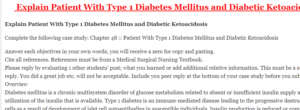Explain Patient With Type 1 Diabetes Mellitus and Diabetic Ketoacidosis
Explain Patient With Type 1 Diabetes Mellitus and Diabetic Ketoacidosis
Explain Patient With Type 1 Diabetes Mellitus and Diabetic Ketoacidosis
Complete the following case study: Chapter 48 :: Patient With Type 1 Diabetes Mellitus and Diabetic Ketoacidosis
Answer each objectives in your own words, you will receive a zero for copy and pasting.
Cite all references. References must be from a Medical Surgical Nursing Textbook.
Please reply by evaluating 1 other students’ post; what you learned or add additional relative information. This must be a substantive reply. You did a great job etc. will not be acceptable. Include you peer reply at the bottom of your case study before you submit it.
Overview
Diabetes mellitus is a chronic multisystem disorder of glucose metabolism related to absent or insufficient insulin supply and/or poor utilization of the insulin that is available. Type 1 diabetes is an immune-mediated disease leading to the progressive destruction of ?-cells as a result of development of islet cell autoantibodies in susceptible individuals. Insulin production is reduced or completely absent. Type 2 diabetes is characterized by increased insulin resistance, decreased secretion of insulin resulting from ?-cell exhaustion, inappropriate hepatic glucose production, and alteration in the production of hormones and cytokines by adipose tissue. Endogenous insulin continues to be produced in type 2 diabetes, but the amount is either insufficient and/or it is poorly used by the tissues. The onset and progression of hyperglycemic symptoms is usually more rapid and acute in type 1 diabetes as compared with type 2, and successful treatment depends on insulin replacement.
Explain Patient With Type 1 Diabetes Mellitus and Diabetic Ketoacidosis
Diabetic ketoacidosis (DKA) is an acute complication that may arise from diabetes mellitus. It is caused by a profound deficiency of insulin and is characterized by hyperglycemia, ketosis, acidosis, and dehydration. DKA is typically associated with type 1 diabetes but may be manifested in type 2 diabetes in conditions of severe illness or stress. Patients with type 2 diabetes usually have enough insulin production to prevent the acidosis that occurs with DKA. Severe hyperglycemia in type 2 diabetes is predominantly manifested as hyperosmolar hyperglycemic syndrome (HHS). Clinical manifestations of DKA include those of dehydration and metabolic acidosis. Acute care management goals for a patient with DKA are aimed at lowering the serum glucose levels and restoring fluid and electrolyte balance.
Objectives
Describe the pathophysiology related to diabetic ketoacidosis (DKA).
Discuss the etiology underlying clinical manifestations for DKA.
Evaluate results of diagnostic testing in a patient with DKA.
Identify relevant assessment data for a patient with DKA.
Prioritize nursing care of a patient with DKA.
Appropriately delegate nursing care of a patient with DKA.
Describe the interprofessional care of a patient with DKA.
Develop an individualized teaching plan for a patient with DKA.
Case Study
J.D. is a 49-year-old Native American male admitted to the ICU with the diagnosis of DKA. J.D’s past medical history includes type 1 diabetes (since the age of 14), hypertension (15 years), CAD (5 years), and chronic kidney disease. This is his third admission to the ICU in the last 6 months for the same diagnosis. He lives alone and frequently does not follow his medical regimen as prescribed. His current prescribed medications include insulin glargine 40 units in the morning with Humalog insulin dosing based on preprandial and bedtime capillary blood glucose monitoring. His laboratory work on admission is as follows: sodium 128 mEq/L, potassium 3.8 mEq/L, chloride 98 mEq/L, and glucose 854 mg/dL. His admission arterial blood gas (ABG) results are pH 7.03, PaCO2 17 mm Hg, PaO2 81 mm Hg, and HCO3 11.6 mEq/L.
Answer preview to patient With Type 1 Diabetes Mellitus and Diabetic Ketoacidosis
APA
744 words
Use the following coupon code :
premiernursingpapers


